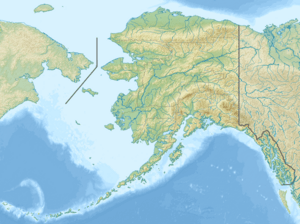Nenana River facts for kids
Quick facts for kids Nenana River |
|
|---|---|

Rafters on the Nenana River, near Denali National Park and Preserve
|
|
|
Location of the mouth of the Nenana River in Alaska
|
|
| Country | United States |
| State | Alaska |
| District | Denali Borough, Matanuska-Susitna Borough, Yukon–Koyukuk Census Area |
| Physical characteristics | |
| Main source | Nenana Glacier Alaska Range, Denali Borough 3,237 ft (987 m) 63°29′43″N 147°48′01″W / 63.49528°N 147.80028°W |
| River mouth | Tanana River Nenana, Yukon–Koyukuk Census Area 344 ft (105 m) 64°33′53″N 149°06′18″W / 64.56472°N 149.10500°W |
| Length | 140 mi (230 km) |
The Nenana River is a river in central Alaska, United States. It is about 140 miles (225 km) long. The river flows from the Alaska Range and joins the larger Tanana River. It helps drain an area on the northern side of the Alaska Range. This area is found southwest of Fairbanks.
Contents
The River's Journey
The Nenana River starts from the Nenana Glacier. This glacier is located in the northern part of the Alaska Range. It is about 100 miles (160 km) south of Fairbanks. The river first flows southwest, then west, and finally north. It forms the eastern border of Denali National Park and Preserve.
As it leaves the mountains, the river enters the wide, marshy Tanana Valley. It then meets the Tanana River from the south. This meeting point is near Nenana, Alaska. The Tanana River then continues its journey to join the Yukon River.
The upper part of the Nenana River valley is important for transportation. About 100 miles (160 km) of this valley is used by both the Alaska Railroad and the Parks Highway. These routes connect Fairbanks and Anchorage.
Amazing River Wildlife
The Nenana River is home to many different kinds of fish. You can find Alaska blackfish and Arctic grayling here. Other fish include Arctic lamprey and various types of whitefish, like broad whitefish and humpback whitefish.
Salmon species like chum salmon, king salmon, and silver salmon also live in the river. Other interesting fish are burbot, lake chubs, least cisco, longnose suckers, northern pike, round whitefish, sheefish, and slimy sculpins.
The river valley also holds important archaeological sites. These sites, like Broken Mammoth and Swan Point, show evidence of very old human activity. They date back to the late Pleistocene period.
How the River Got Its Name
In 1887, a U.S. Army officer named Lieutenant Henry Tureman Allen explored the Nenana River. He first called it the Cantwell River. This was to honor Lieutenant John C. Cantwell of the Revenue Cutter Service. Cantwell had explored the Kobuk River area earlier.
Later, in 1898, members of the United States Geological Survey found out something new. People living along the river called it Tutlut. However, a map made later used the local Tanana name, spelled Nenana.
A century later, a linguist named William O. Bright studied the name. He wrote that Nenana comes from the Lower Tanana (Athabascan) word neenano'. This word means the "stopping-while-migrating stream."
Boating and Rafting Adventures
The Nenana River is a very popular spot for boating and whitewater rafting in Alaska. Thousands of people enjoy trips on the river every year. Some go on guided tours, while others take their own private trips.
The river is easy to get to. The Denali Highway runs next to the upper river for about 15 miles (24 km). The Parks Highway follows the river for about 80 miles (129 km). This makes it easy to access the river at many points.
River Difficulty Levels
The river starts as a Class I (easy) rafting stream. This is according to the International Scale of River Difficulty. Jetboats and other small boats can use these waters near the Denali Highway.
Further downstream, the river gets faster. It becomes a Class I to II (medium) stream for about 38 miles (61 km). This section is between Windy Station and McKinley Village Lodge.
The most challenging part is in the Nenana Gorge. This 23-mile (37 km) section, between McKinley Village and Healy, is rated Class IV (very difficult). This part is only for expert rafters. After the gorge, the river becomes Class I or II again all the way to Nenana.
Staying Safe on the River
Boating on the Nenana River has some dangers to be aware of. The water is extremely cold and moves very fast. The Class IV rapids in the gorge are very difficult.
In the upper river, watch out for trees hanging over the water. On the lower river, there can be overhangs, logjams, and braids (where the river splits into many channels).
A big danger at the river mouth is following the wrong braid. If you miss the take-out point at Nenana, you could be swept into the Tanana River. From there, it might be hard to exit until you reach Manley Hot Springs, which is 90 miles (145 km) further downstream! Always be careful and know your route.
Images for kids
See also
 In Spanish: Río Nenana para niños
In Spanish: Río Nenana para niños





